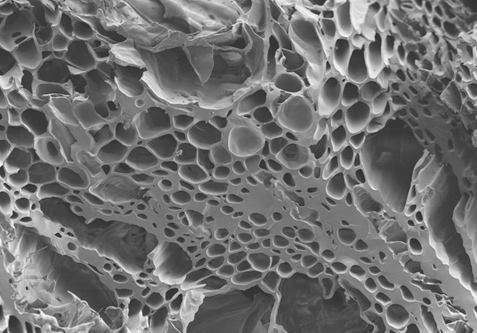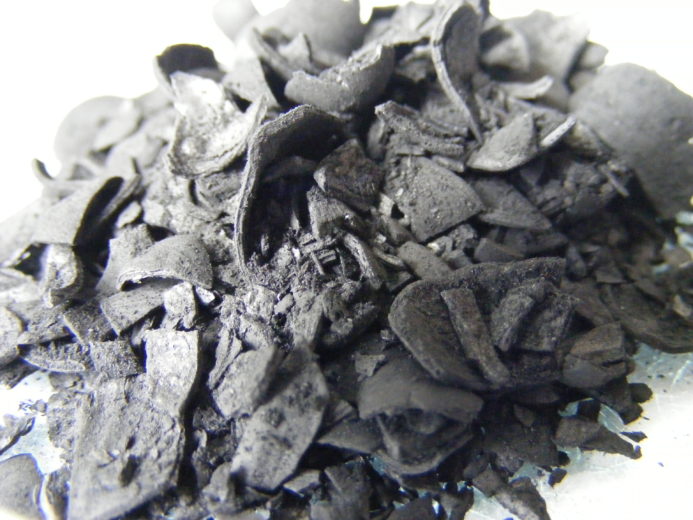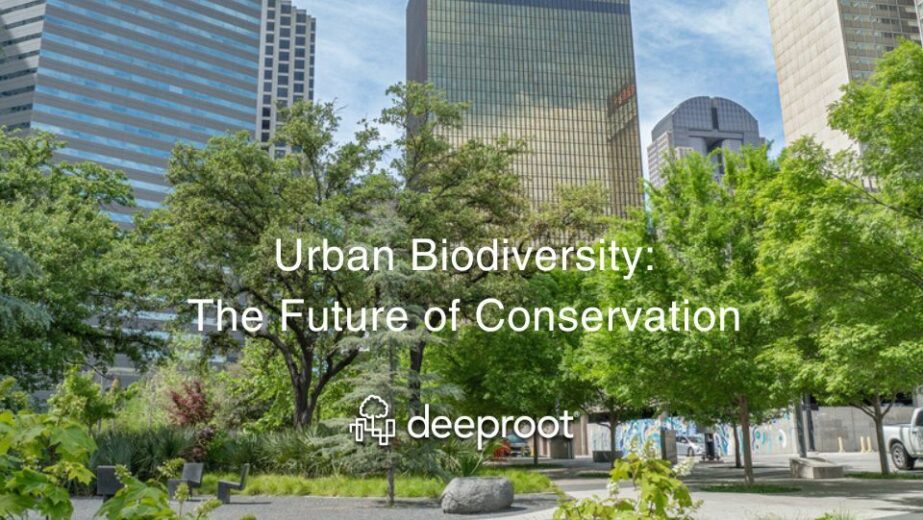If you are a regular reader of this blog, then you know we’ve had a recent spate of articles about biochard – from its history, to a discussion of possible applications and controversies, to a question-and-answer following a recent webinar about what designers need to know about the product. Because of the tremendous potential for trees and biochar to provide stormwater benefits, we also wanted to delve into the state of the science of using biochar to improve stormwater benefits of tree/soil SCMs (Stormwater Control Measures).
Stormwater benefits in a nutshell
You may already know that, supplemented with compost or fertilizer, biochar can greatly improve tree health and aesthetics. With its high surface area and porosity, biochar has the potential to not only enhance tree health by increasing nutrient and moisture retention, but to also provide tremendous stormwater benefits. Stormwater benefits of biochar documented to date are summarized below.
Escherichia coli (E. Coli)
While biofilters are generally ineffective in removing bacteria from stormwater, biofilters amended with biochar show great promise for E. Coli removal (e.g. Mohanty and Boehm 2015, Mohanty and Boehm 2014, Mohanty et al 2014). Mohanty et al (2014) found that “Compared to sand, biochar not only retained up to 3 orders of magnitude more E. coli, but also prevented their mobilization during successive intermittent flows.”
Heavy metals
Lab and field tests show that certain biochar amended soils can remove high levels of heavy metals from water, with 80-97% of copper and zinc removal (Gray et al 2015). However, metal removal by biochar is highly variable, depending on a number of factors, including the ionic radius of the metal, temperature at which biochar is produced, and pH.
In some cases, heavy metals actually increased in water with biochar. Gray et al (2015), for example, found that unrinsed biochar can emit a pulse of contaminants if not rinsed prior to installation. Ahmad et al (2014) includes a detailed review on studies of factors affecting biochar effects of heavy metals in soil and water.
Nutrients
Green roof trays with 7% biochar showed significant decreases in discharge of total nitrogen, total phosphorus, nitrate, phosphate, and organic carbon, as well as reduced turbidity of rainfall (Beck et al 2001). Additionally, lab experiments indicate potential to remove ammonium with biochar amended sand (Tian et al 2014).
As Kelby Fite mentioned in “Your Biochar Questions, Answered” fresh biochar is also used to clean the effluent coming from dairies, resulting in a relatively nutrient-free effluent leaving the facility. The biochar that has sorbed nutrients from the dairies “can then be used for use in an agricultural or horticultural setting – it’s now more valuable than it was before.”
Reduced turbidity
Green roof trays with 7% biochar showed reduced turbidity of rainfall (Beck et al 2001).
Organic contaminants
Recent lab studies show that biochar can effectively be used to reduce organic contaminants like gasoline compounds, polychlorinated biphenyls (PCB), polyaromatic hydrocarbons (PAH), and some herbicides, pesticides, and pharmaceuticals (Pacific Northwest Pollution Prevention Center).
A literature review by Ahmad et al (2014) summarizes “Overall, the biochars produced at higher temperatures exhibit higher sorption efficiency for organic contaminant remediation in soil and water. This is probably due to the high surface area and microporosity of biochars. Additional sorption mechanisms include electrostatic attractions between charged surfaces of biochars and ionic organic compounds.”
Water retention
Biochar’s contribution to increased water retention capacity is not only a stormwater benefit but can also benefit plant health. Ahmad et al (2014) summarize research on biochar and water retention as follows: “About 18% increase in the water holding capacity of soil containing biochar was reported (Glaser et al., 2002). Soil water holding capacity is related to hydrophobicity and surface area of biochar, and the improved soil structure following biochar application (Verheijen et al., 2010).”
Green roof trays with 7% biochar showed increased water retention (Beck et al 2001).
Ways to incorporate biochar into SCMS
Although using biochar for stormwater benefits is in its infancy, biochar has already been incorporated into SCMs in many different ways, including:
- Mixed into green roof or bioretention soil as a soil amendment
- Incorporated into downspout filter
- Incorporated into in ground filter
- Incorporated into wattles
Bartlett Tree Research Laboratory is also investigating injecting biochar into urban tree soils. If you have incorporated biochar into SCMs in any other ways, please let us know!
Variables affecting stormwater benefits
Factors that affect biochar pollutant removal include surface area, pore size distribution, ion-exchange capacity, and pH. These are influenced by the type of biomass and the process used to make biochar, including pyrolysis temperature, residence time, and heat transfer rate (insert images from slide 38 from webinar). According to Ahmad et al (2014):
“Relatively high pyrolysis temperatures generally produce biochars that are effective in the sorption of organic contaminants by increasing surface area, microporosity, and hydrophobicity; whereas the biochars obtained at low temperatures are more suitable for removing inorganic/polar organic contaminants by oxygen-containing functional groups, electrostatic attraction, and precipitation.”
Conclusion
While the use of biochar in SCMs is in its infancy, and many questions remain to be answered, the potential of biochar to enhance SCM performance looks very promising. The use of biochar to enhance stormwater benefits is all the more appealing because it also provides so many other benefits, including enhanced plant health, growth, and disease resistance; improved soil structure; Carbon sequestration, and turning waste biomass into an asset.
References
Ahmad, M, Anushka Upamali Rajapaksha , Jung Eun Lim, Ming Zhang, Nanthi Bolan, Dinesh Mohan, Meththika Vithanage, Sang Soo Lee, Yong Sik Ok. 2014. Biochar as a sorbent for contaminant management in soil and water: A review. Chemosphere 99 (2014) 19–33.
Beck DA, Johnson GR, Spolek GA. 2011. Amending greenroof soil with biochar to affect runoff water quantity and quality. Environmental Pollution 159(2011):2111-8. doi: 10.1016/j.envpol.2011.01.022. Epub 2011 Feb 12.
Gray, Myles, Al Cairns, Francesco Tortorici, Joe Kalmar, John Miedema. 2015. Port Of Port Townsend Biochar Stormwater Filtration Feasibility Study. Washington State Department of Commerce Grant #F14B52216B006 Final Report.
Mohanty Sanjay K., Boehm, Alexandria B. 2015. Effect of weathering on mobilization of biochar particles and bacterial removal in a stormwater biofilter Water Research 85 (2015) 208e215
Mohanty, S.K., Boehm, A.B., 2014. Escherichia coli removal in biochar-augmented biofilter: Effect of infiltration rate, initial bacterial concentration, biochar particle size, and presence of compost. Environ. Sci. Technol. 48 (19), 11535e11542.
Mohanty, S.K., Cantrell, K.B., Nelson, K.L., Boehm, A.B., 2014. Efficacy of biochar to remove Escherichia coli from stormwater under steady and intermittent flow. Water Res. 61, 288e296.
Pacific Northwest Pollution Prevention Center. Emerging Best Management Practices in Stormwater:Biochar as Filtration Media. Downloaded 5/1/2016 from http://pprc.org/wp-content/uploads/2014/08/Emerging-Stormwater-BMPs_Biochar-as-Filtration-Media_2014.pdf
Trigo, C., Spokas, K.A., Cox, L., Koskinen, W.C., 2014. Influence of soil biochar aging on sorption of the herbicides MCPA, nicosulfuron, terbuthylazine, indaziflam, and fluoroethyldiaminotriazine. J. Agric. Food Chem. 62 (45), 10855e10860.
Tian, J., Yi, S., Imhoff, P., Chiu, P., Guo, M., Maresca, J., Beneski, V., and Cooksey, S. (2014) Biochar-Amended Media for Enhanced Nutrient Removal in Stormwater Facilities. PROCEEDINGS of the World Environmental and Water Resources Congress 2014: pp. 197-208.
Nathalie Shanstrom is a sustainable landscape designer with The Kestrel Design Group.







Leave Your Comment